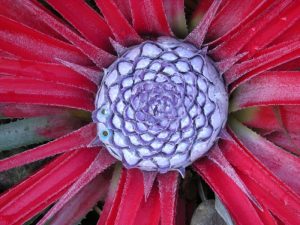These two xerophytic members of the Bromeliaceae withstand neglect as long as they are in direct sunlight. Both native to Chile, central and southern respectively where they colonise large areas of ground that then becomes impenetrable.
- Fascicularia bicolor is the less vigorous of the two species growing in the garden. A plant in the south bed of the rock garden has the most intense red colour to the leaves of any I have seen in cultivation. This is a propagule from Combers original introduction in 1927, during his second visit to South America, collection number 1015. H.F.Comber found it growing 800 – 2000ft near the Indian village of Calafquen in central Chile. On departing Comber “then travelled by the worst road he has ever encountered”. Harold Frederick Comber was born at Nymans Garden where his father was a noted gardener. He studied at the Royal Botanic Garden Edinburgh from 1920 and in 1925 was asked by the Andes Syndicate, comprising amongst others; The Hon. Henry D. McLaren; later Lord Aberconway of Bodnant Garden; A.K.Bulley of Ness; Col. Messel of Nymans to visit Chile and Argentina on a collecting expedition. As a student on the DHE course he obtained very good marks: 100% in Cryptogrammic Botany, 96% in each of Botanical Nomenclature and Classification of Plants showing him to be eminently suited to this opportunity.
- Fascicularia pitcairniifolia can be seen as a dense clump in the border to the south of the Front Range glasshouse. Don’t be tempted to reach into the rosette of leaves; each is edged with saw teeth that will rip the skin apart. Conversely gently running your fingers up the length of the leaf will not cause any damage as the teeth all face in the one upward pointing direction. Comber described the leaves as scurfy. The flowers appear in a packed domed inflorescence in the base of these recurved leaves. Initially dusted with grey farina the petals are a lurid shade of blue. Opening from the outer circumference towards the centre of the inflorescence then fading brown. Fruits if produced are juicy, sweet and edible.

